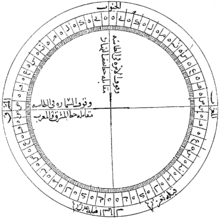Al-Ashraf Umar II
| al‐Malik al‐Ashraf | |
|---|---|
 Al-Ashraf's diagram of the compass and Qibla, copied in Yemen, 1293.[1] | |
| Born | circa 1242 |
| Died |
22 November 1296 Yemen |
| Scientific career | |
| Fields | Astronomy |
al‐Malik al‐Ashraf (Mumahhid al‐Dīn) ʿUmar ibn Yūsuf ibn ʿUmar ibn ʿAlī ibn Rasūl (born c. 1242, died 22 November 1296 in Yemen) was the third Rasulid sultan and a polymath.[2] He is known for writing the first description of the use of a magnetic compass for determining the qibla.[2] Also, his works on astronomy contain important information on earlier sources.[2]
In a treatise about astrolabes and sundials, al-Ashraf includes several paragraphs on the construction of a compass bowl (ṭāsa). He then uses the compass to determine the north point, the meridian (khaṭṭ niṣf al-nahār), and the Qibla towards Mecca. This is the first mention of a compass in a medieval Islamic scientific text and its earliest known use as a Qibla indicator, although al-Ashraf did not claim to be the first to use it for this purpose.[1][2]
Notes
- 1 2 Schmidl, Petra G. (1996–97). "Two Early Arabic Sources On The Magnetic Compass". Journal of Arabic and Islamic Studies. 1: 81–132. http://www.uib.no/jais/v001ht/01-081-132schmidl1.htm#_ftn4 Archived 2014-09-02 at the Wayback Machine.
- 1 2 3 4 Schmidl 2007.
References
- Schmidl, Petra G. (2007). "Ashraf: al‐Malik al‐Ashraf (Mumahhid al‐Dīn) ʿUmar ibn Yūsuf ibn ʿUmar ibn ʿAlī ibn Rasūl". In Thomas Hockey; et al. The Biographical Encyclopedia of Astronomers. New York: Springer. pp. 66–7. ISBN 9780387310220. (PDF version)